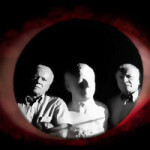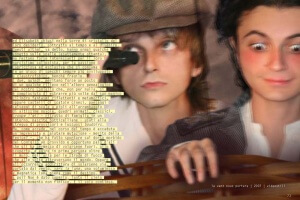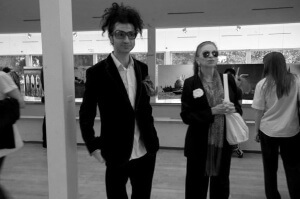Domenico Quaranta – Alice does yoga
When Alice meets the white rabbit for the first time she is getting bored on a river bank with her sister. She follows the rabbit under the hedge, then down a deep hole into a room full of doors, bottles and cakes, and from there into a wonderland that with the help of Lewis Carroll, she ends up sharing with us. When Alice meets ConiglioViola she is getting bored in front of a computer. Idly clicking here and there, like her namesake she is pondering what use “a book without pictures and dialogue” can have. It was 2001 and the internet was pretty much similar to a book without pictures and dialogue, a place devoted to serendipity but at the same time fairly devoid of surprises. ConiglioViola pulls Alice into the vortex of a surreal experience, an online “meditation”. What appears is Yolanda, a strange robot sitting in the lotus position, with seven flashing chakras. Alice is invited to undertake a personal process of meditation using Yolanda’s chakras. Clicking on each chakra activates a series of hypnotic animations designed to aid meditation. When she encounters Yolanda Alice is unable to recognise Maria, the robot woman in Metropolis by Fritz Lang (1927). Her film culture is limited to teen films and Dawson’s Creek, a TV series which was all the rage at the time. She doesn’t think the site’s aesthetics kitsch, or ponder the suitability of a computer screen for yoga meditation. And in any case Alice does yoga, or at least has taken a few lessons. She immediately forwards the link to her classmates and on the Saturday shows her instructor the site. So was it that in 2001, ConiglioViola’s project acquired a cult following among devotees of New Age philosophies.
La meditazione di Yolanda was used both in private and during lessons. ConiglioViola was not that surprised, having enough familiarity with the web to know that works online can meet with entirely unpredictable fates. Parodies can get mistaken for originals, and extreme provocations taken on board as practical suggestions that might just be good business ideas. In this context there is nothing strange about a discreet reflection on the computer screen as mirror for the self, a projection of its user and a place of life rather than a device for work, becoming a tool for meditation, and nothing strange about a subtle mockery of New Age philosophies actually eliciting identification from those seriously engaged in those philosophies. In 2001, in any case, the identity of ConiglioViola itself was still in the process of forming. Established with the aim of creating multimedia works and reaching the widest audience possible, it did not take for granted that art would represent the best channel for this activity. In the meantime the internet appeared to respond to both of these expectations, and ConiglioViola enthusiastically embraced its promise. In 2003 Yolanda’s Meditation expanded to include a “temple”, a new, unsettling and surreal dimension that users can access after meditating on the seven chakras, and that enables them to contribute personal thoughts to a kind of online collective unconscious. In the meantime the group’s considerations on theatre and the idea of using the internet as a performative space led to the creation of another work on the web: Secret.Room (2004). The project sprang from a partnership with the Italo-Australian theatre company IRAA Theatre. The show The Secret Room was an experiment in interactive theatre divided into two parts. In the first part ten people are invited to the home of Roberta, the main character. Roberta and her guests get chatting, in a relaxed, intimate atmosphere. The guests are then invited into Roberta’s “secret room” to reveal their secret, distressing stories in private. ConiglioViola’s web project is also structured in two parts. When you open the site a disquieting animation informs you that “the computer is your secret room” and “the browser is your director”. You are then bombarded with a barrage of pop-ups, each of which contains a video. The unexpected behaviour of the site (which recalls the spamming strategies adopted by porn sites), together with the size of the video clips, is a trial both for you – comprehensibly dismayed – and your computer, which may have problems dealing with all this material. If you both make it through, and if you have the patience to wade through around 50 pop-ups crowding the screen, you might come across a pop-up containing a gate with a bell. You ring the bell. If Roberta decides to let you in, you will be asked to leave an email address. A few hours or days later you will receive an email from Roberta, setting an appointment. If you still haven’t tired of it all, and if circumstances do not prevent you from visiting the website at that particular time on that particular day, you will finally gain access to the secret room. Before revealing its contents, let us consider for a moment the subtle game staged by ConiglioViola. Intent on translating a theatre show into a “net.drama”, ConiglioViola carefully avoids the path of “augmented reality”, namely taking part in the real event via the internet. The group prefers to use the web to create a situation which reflects the original version of the show, but at the same time is closely bound to the language and dynamics of the web. In place of the concept of interactivity, which on the net means little more than clicking here and there in search of links, comes that of participation: suffered, sought after and obtained by the user amid delays and surprises. The real scene, filmed by ConiglioViola during its visit to Roberta’s “secret room”, is present in the video clips which appear in entirely random and ever variable order, making it impossible to reconstruct with clarity. The appointment mechanism generates expectations, but at the same time violates one of the web’s unwritten rules, that a visitor forced to return in order to gain access to content is a visitor lost. Everything is engineered so as not to grant us access to the secret room, or to ensure that visitors undergo a strict selection process (another violation of the web’s unwritten rules). Those who were undaunted by the flood of pop-ups, and patiently sought out the way into the “secret room”, turning up on time at the appointed hour, will not be surprised to discover that the secret room is nothing more than the site’s root, the page in which the project shows not its interface, but its structure. As happened to Neo, the lead character in The Matrix (1999), the sight of the code, a routine vision for all those who programme the net, becomes a cathartic experience for common users, destined to render them immune to the allure of the web. Neo brings us back to the White Rabbit, and in turn to Alice. In the following years the net remained ConiglioViola’s creative platform, the venue where the collective worked much of its magic: the legends surrounding the departure of the pirate attack on the Biennale, an inexhaustible source of imagination and post-production work on images. Other works on the web occasionally came into being, like Un’estate al mare (a vj-set in the form of a Flash game which acts as a teaser for the project Recuperate le Vostre Radici Quadrate) and Bertepolis, a glaringly camp Flash movie dedicated to Loredana Berté. But after being present for so many years, what now strikes us is the collective’s absence: in an era when sites long outlive their creators, the ‘interval’ message which now limits access to the ConiglioViola website spells more than just a break to mull things over, representing yet another theatricalization of the collective’s existence.
Domenico Quaranta

 Previous Post
Previous Post Next Post
Next Post


